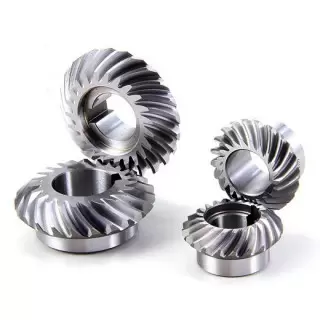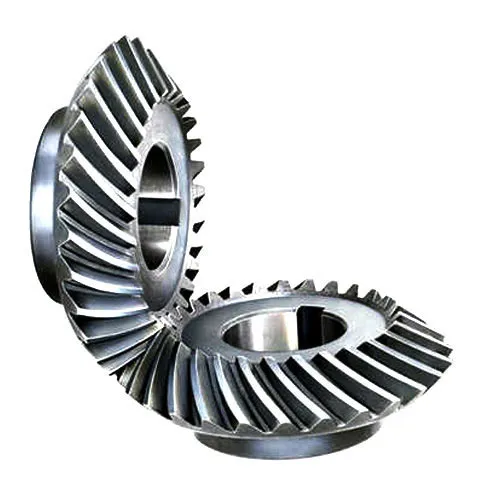Product Description
MW Spur Helical Pinion Shaft Galvanized Worm Gear Spiral Bevel Gear with Spline
Operating principle
A special design of the CZPT is the so-called worm. In this case, the tooth winds around the worm shaft like the thread of a screw. The mating gear to the worm is the worm gear. Such a gearbox, consisting of worm and worm wheel, is generally referred to as a worm drive.
Power transmission
In worm drives, power is transmitted almost exclusively through sliding between the flanks of the worm and the worm gear, i.e. the flanks slide CZPT each another as a screw. Worms are ultimately a special case of screw gears. In contrast to screw gears, which generate a point-shaped flank contact, worms have a linear flank contact. This results in the advantage of transmitting higher power at higher transmission ratios.
Due to the sliding processes and the associated friction on the flanks, the efficiency of worm drives is generally lower than wirh spur gear drives or bevel gear drives. Due to the heat generated by friction, worm drives must be cooled at high power transmissions in addition to lubrication.
1.High skilled and well-trained working team under good management environment;
2. Quick response and support for any inquiries;
3. Over 10 years professional manufacture experience to ensure high quality of your products;
4. Large and strong production capacity to meet your demand;
5. High Quality standard and hygienic environment;
6. We have very strict quality control process:
a. In coming Quality control (IQC) – All incoming raw material are checked before used.
b. In process quality control (IPQC) – Perform inspections during the manufacturing process.
c. Final quality control (FQC) – All finished goods are inspected according to our quality
standard for each products.
d. Outgoing Quality Control (OQC) – Our QC team will 100% full inspection before it goes
out for shipment.
7. Good after sales services;
Material Available:
| Stainless Steel | SS201,SS301, SS303, SS304, SS316, SS416 etc. |
| Steel | mild steel, Carbon steel, 4140, 4340, Q235, Q345B, 20#, 45# etc. |
| Brass | HPb63, HPb62, HPb61, HPb59, H59, H68, H80, H90 etc. |
| Copper | C11000,C12000,C12000 C36000 etc. |
| Advantages | »Reliable CNC service »Good machining quality »Reasonable Pricing provided »Competitive shipping cost service »MOQ 1PCS and small quantity order accepted »Professional engineering service when any modification required »Any turnkey assembly or customized package requirements, we’ll meet your demands! |
| RFQ | Customer Inquiry →Engineering Communication →Cost Analysis →Sales Analysis →Quote to Customer » 1-3 Work Days Only » Submit RFQ with complete commercial terms |
| Sample Making | Sample Order → Engineering Review → Sample Plan to Customer → Sample Status Tracking → Submit Samples with Doc. » Tooling L/T: 2-4 weeks, Sample L/T: 1 week » Continuous Sample Status Tracking » Complete Documents for sample approval |
| Order Management | CRM System → Open Order Confirm → Logistic Arrangement. » Production L/T: 2-4 wks » Weekly Open Order Confirm » Preferred 3PL Service to Customers |
| Quality Control | Certificates: RoHS, ISO9001:2008, SGS. IQC → IPQC → OQC/FQC → Quality Complain Feedback → Audit & Training. » Plant Audit and Qualified by world famous company » Strict Quality Management Procedure with Traceability |
| Application | »Aerospace »Marine »Motorbike »Automotive »PhotoGear »EDC Tools » lighting fittings »Office equipment »Home appliance »Medical equipment »Telecommunication »Electrical & Electronics »Fire detection system, etc. |
Inspections:
3D instruments, 2D instruments, Projectors, Height Gauges, Inner diameter dial indicators, Dial gaues,
Thread and Pin gauges, Digital calipers,Micro calipers, Thickness testers, Hardness testers Roughness
testers, etc.( Detection accuracy to 0.001 millimetre )
Q: Why choose CZPT product?
A: We CZPT have our own plant– HangZhou CZPT machinery Co.,Ltd, therefore, we can surely
promise the quality of every product and provide you comparable price.
Q: Do you provide OEM Service?
A: Yes, we provide OEM Service.
Q: Do you provide customized precision machining parts?
A: Yes. Customers give us drawings and specifications, and we will manufact accordingly.
Q: What is your payment term?
A: We provide kinds of payment terms such as L/C, T/T, Paypal, Escrow, etc.
Quality First,Price Best,Service Foremost!
We assure you of our best services at all times !
|
Shipping Cost:
Estimated freight per unit. |
To be negotiated |
|---|
| Standard or Nonstandard: | Nonstandard |
|---|---|
| Application: | Textile Machinery, Garment Machinery, Conveyer Equipment, Packaging Machinery, Electric Cars, Motorcycle, Food Machinery, Marine, Mining Equipment, Agricultural Machinery, Car |
| Spiral Line: | Right-Handed Rotation |
| Samples: |
US$ 5/Piece
1 Piece(Min.Order) | Order Sample 3pcs
|
|---|
| Customization: |
Available
| Customized Request |
|---|

What lubrication and maintenance practices are required for spiral gears?
Spiral gears require proper lubrication and maintenance to ensure optimal performance and longevity. Here are the recommended lubrication and maintenance practices for spiral gears:
- Lubrication: Adequate lubrication is essential for smooth gear operation and to minimize wear. The lubricant forms a protective film between the gear teeth, reducing friction and preventing metal-to-metal contact. It is crucial to use a lubricant that is compatible with the gear material, operating conditions, and load requirements. Regular lubrication intervals should be followed, and the lubricant should be replenished as needed.
- Lubricant Selection: The selection of the lubricant depends on various factors such as gear speed, load, temperature, and environment. It is recommended to consult the gear manufacturer or lubrication experts to determine the most suitable lubricant for the specific application. The lubricant should have appropriate viscosity, additives, and temperature resistance to provide effective lubrication and protect against wear and corrosion.
- Lubricant Application: The lubricant should be applied evenly to the gear teeth and mating surfaces. Depending on the gear design and accessibility, lubrication can be done through oil bath immersion, oil splash, forced circulation, or grease application. It is important to follow the gear manufacturer’s guidelines or industry best practices for proper lubricant application.
- Monitoring and Inspection: Regular monitoring and inspection of the gear condition are essential for early detection of any abnormalities or signs of wear. This can include visual inspections, checking for unusual noise or vibrations, and measuring gear backlash and tooth wear. Monitoring can help identify potential issues and allow for timely maintenance or lubricant adjustments before significant damage occurs.
- Cleaning and Contaminant Control: Regular cleaning of the gears and their surrounding areas is necessary to remove dirt, debris, and contaminants that can affect gear performance and lubrication. Contaminants can accelerate wear and cause damage to the gear teeth. Proper sealing and contamination control measures should be implemented to minimize the ingress of contaminants into the gear system.
- Maintenance Schedule: Establishing a maintenance schedule is important to ensure timely lubricant replenishment, gear inspections, and necessary repairs or replacements. The maintenance schedule should consider the operating conditions, gear load, and manufacturer’s recommendations. Adhering to a well-planned maintenance schedule helps prolong the service life of spiral gears and ensures their continued performance.
By following these lubrication and maintenance practices, spiral gears can maintain their efficiency, durability, and reliability over time. Regular attention to lubrication, monitoring, and maintenance contributes to the smooth operation and extended lifespan of spiral gears in various applications.

What is the impact of helix angle on spiral gear performance?
The helix angle plays a crucial role in determining the performance characteristics of spiral gears. It affects various aspects of gear operation and functionality. Here’s the impact of the helix angle on spiral gear performance:
- Load-Carrying Capacity: The helix angle influences the load-carrying capacity of spiral gears. A larger helix angle results in a more pronounced helical shape of the teeth, providing a larger contact area between the gears. This increased contact area allows spiral gears to distribute the load over more teeth, thereby increasing their load-carrying capacity. Gears with larger helix angles can handle higher loads and transmit more torque.
- Smoothness of Operation: The helix angle significantly affects the smoothness of gear operation. A larger helix angle leads to a more gradual tooth engagement as the gears mesh. This gradual engagement reduces impact and vibration during gear meshing, resulting in smoother operation and reduced noise levels. Spiral gears with larger helix angles are known for their quiet operation and enhanced gear meshing characteristics.
- Efficiency and Power Transmission: The helix angle also influences the efficiency of power transmission in spiral gears. A larger helix angle reduces sliding friction between the teeth during meshing. This reduction in friction results in improved power transmission efficiency and reduced energy losses. Gears with larger helix angles are more efficient in transmitting power, making them suitable for applications where power efficiency is a critical factor.
- Axial Thrust and Thrust Load: The helix angle affects the axial thrust and thrust load in spiral gears. Axial thrust is the force generated in the axial direction due to the helical tooth arrangement. A larger helix angle produces a higher axial thrust, while a smaller angle generates a lower axial thrust. The axial thrust must be considered and managed in gear design to ensure proper gear support and minimize the need for additional thrust bearings.
- Contact Pattern and Gear Meshing: The helix angle influences the contact pattern between the teeth during gear meshing. A larger helix angle shifts the contact pattern across the tooth face, allowing for more even distribution of the load and reduced stress concentration. The contact pattern also affects the gear meshing characteristics, such as tooth wear and noise generation. Proper selection of the helix angle ensures optimal contact pattern and improved gear meshing performance.
The choice of helix angle in spiral gears depends on the specific application requirements, including load capacity, smoothness of operation, power transmission efficiency, and axial thrust considerations. By selecting an appropriate helix angle, engineers can optimize spiral gear performance for different applications, ensuring reliable and efficient gear operation.

What industries commonly use spiral gears in their applications?
Spiral gears, also known as helical gears, find applications in various industries due to their unique design and advantages. Here are some industries that commonly use spiral gears:
- Automotive: Spiral gears are widely used in the automotive industry, particularly in applications such as gearboxes and automotive differentials. They provide efficient power transmission, smooth operation, and the ability to handle high torque loads.
- Industrial Machinery: Many industrial machinery applications benefit from the use of spiral gears. These include heavy-duty machinery such as mining equipment, construction machinery, and manufacturing machinery. Spiral gears provide high load capacity, efficient power transmission, and reduced noise levels.
- Power Generation: Spiral gears are utilized in power generation systems such as wind turbines, hydroelectric turbines, and steam turbines. They play a critical role in transmitting power from the turbine to the generator, providing efficient and reliable power transmission in these energy production systems.
- Aerospace and Defense: The aerospace and defense industries employ spiral gears in various applications, including aircraft engines, missile systems, and satellite mechanisms. Spiral gears offer high load capacity, efficient power transmission, and the ability to withstand demanding operating conditions.
- Machine Tools: Spiral gears are commonly used in machine tools, such as milling machines, lathes, and grinding machines. These gears contribute to the smooth and precise motion of the tools, ensuring accurate machining operations.
- Robotics and Automation: Spiral gears are utilized in robotics and automation systems for their ability to provide precise and efficient motion transmission. They are crucial components in robotic arms, automated assembly lines, and other industrial automation applications.
These are just a few examples of industries that commonly use spiral gears. However, spiral gears can be found in various other applications where the advantages of smooth operation, high load capacity, efficient power transmission, and reduced noise levels are desired.


editor by CX 2023-09-12